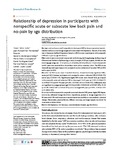Relationship of depression in participants with nonspecific acute or subacute low back pain and no-pain by age distribution

Use este enlace para citar
http://hdl.handle.net/2183/30019
A non ser que se indique outra cousa, a licenza do ítem descríbese como Atribución-NoComercial 3.0 España
Coleccións
- Investigación (FEP) [507]
Metadatos
Mostrar o rexistro completo do ítemTítulo
Relationship of depression in participants with nonspecific acute or subacute low back pain and no-pain by age distributionAutor(es)
Data
2017-01Cita bibliográfica
Calvo-Lobo C, Vilar Fernández JM, Becerro-de-Bengoa-Vallejo R, Losa-Iglesias ME, Rodríguez-Sanz D, Palomo López P, López López D. Relationship of depression in participants with nonspecific acute or subacute low back pain and no-pain by age distribution. J Pain Res. 2017;10:129-135 https://doi.org/10.2147/JPR.S122255
Resumo
[Abstract] Background and purpose: Nonspecific low back pain (LBP) is the most prevalent musculoskeletal condition in various age ranges and is associated with depression. The aim of this study was to determine the Beck Depression Inventory (BDI) scores in participants with nonspecific LBP and no-pain by age distribution.
Methods: A case–control study was carried out following the Strengthening the Reporting of Observational Studies in Epidemiology criteria. A sample of 332 participants, divided into the following age categories: 19–24 (n=11), 25–39 (n=66), 40–64 (n=90), 65–79 (n=124), and ≥80 (n=41) years was recruited from domiciliary visits and an outpatient clinic. The BDI scores were self-reported in participants with nonspecific acute or subacute (≤3 months) LBP (n=166) and no-pain (n=166).
Results: The BDI scores, mean ± standard deviation, showed statistically significant differences (p<0.001) between participants with nonspecific acute or subacute LBP (9.590±6.370) and no-pain (5.825±5.113). Significantly higher BDI scores were obtained from participants with nonspecific acute and subacute LBP in those aged 40–64 years (p<0.001; 9.140±6.074 vs 4.700±3.777) and 65–79 years (p<0.001; 10.672±6.126 vs 6.210±5.052). Differences were not significant in younger patients aged 19–24 (p=0.494; 5.000±2.646 vs 8.250±7.498), 25–39 (p=0.138; 5.440±5.245 vs 3.634±4.397), and in those aged ≥80 years (p=0.094; 13.625±6.1331 vs 10.440±5.591).
Conclusion: Participants with nonspecific acute and subacute LBP present higher BDI depression scores, influenced by age distribution. Specifically, patients in the age range from 40 to 80 years with LBP could require more psychological care in addition to any medical or physical therapy. Nevertheless, physical factors, different outcomes, and larger sample size should be considered in future studies.
Palabras chave
Depression
Depresión
Low back pain
Lumbalgia
Musculoskeletal diseases
Enfermedades musculoesqueléticas
Age distribution
Distribución por edad
Depresión
Low back pain
Lumbalgia
Musculoskeletal diseases
Enfermedades musculoesqueléticas
Age distribution
Distribución por edad
Versión do editor
Dereitos
Atribución-NoComercial 3.0 España






